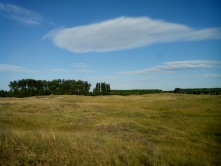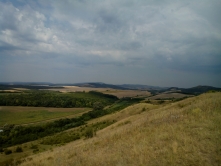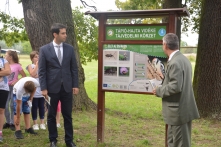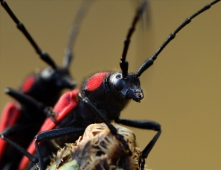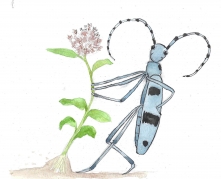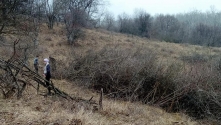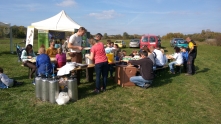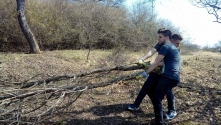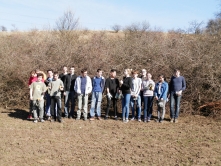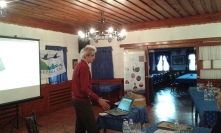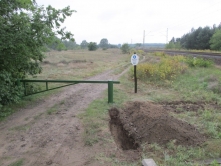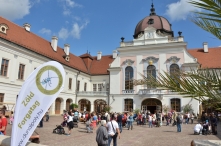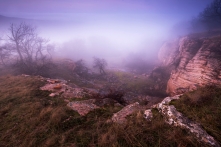In the framework of this 5-year-long project – started in September 2013 – Duna-Ipoly National Park Directorate (DINPD) is directly aiming at the protection of the following priority habitat types: Sub-Pannonic steppic grasslands (6240), pannonic loess steppic grasslands (6250) and Pannonic sand steppes (6260).
SUMMARIES OF RESEARCH REPORTS >>
Layman's report >>
These grasslands provide habitat for numerous protected plant and animal species, that are unique, rare species in Hungary, they occur in a small number or cannot be found abroad at all (for example red-flowered viper’s bugloss /Echium maculatum/, greater pasque flower /Pulsatilla grandis/, sand saffron /Colchicum arenarium/, Laxmann’s bugle /Ajuga laxmannii/, dwarf Russian almond /Prunus tenella/ or Hungarian ground beetle /Carabus hungaricus/ and Hungarian zephyr blue /Plebejus sephirus/).
The project has 9 project sub-sites on 8 Natura 2000 sites covering a total project area of app. 645 ha. These grasslands are generally in good conservation status with many protected species, but are endangered by spontaneous reforestation, spread of invasive species and various types of negative human impacts.
The 9 project areas are as follows:
1. earth fort of Tápióság in the area of Alsó-Tápió és patakvölgyek (HUDI20050)
2. Budaörsi kopárok (HUDI20010)
3. Debegió-hegy (HUDI20014)
4. „Gyermely-Máriahalom” grassland in the area of Epöli szarmata vonulat (HUDI20016)
5. Tétény-fennsík in the area of Érd-tétényi plató (HUDI20017)
6. shooting range of Szentmártonkáta in the area of Felső-Tápió (HUDI20019)
7. Bárányjárás of Domonvölgy in the area of Gödöllői-dombság (HUDI20023)
8. Küdői-hegy in the area of Gödöllői-dombság (HUDI20023)
9. Fóti Somlyó in the area of Gödöllői-dombság peremhegyei (HUDI20010).
Land use has changed significantly related to dry grasslands in the last decades, as extensive livestock farming decreased sharply in Hungary. Consequently, these habitats are now threatened by spontaneous reforestation on many sites (e.g. by Crataegus monogyna). Without urgent intervention this process will conclude in the radical shrinkage or even complete disappearance of the given dry grassland biome. Elimination of shrubs is planned on 8 project sub-areas on a total area of 118 ha in order to avoid further diminish of grasslands. Another problem is the spread of invasive species. 7 project sub-areas are infected with invasive species, mainly black locust, black pine and common milkweed. In the course of the project DINPD is eliminating these invasive species from all three priority grasslands habitats: 42 ha of black locust, 12,5 ha of black pine and 24,4 ha of non-arboreal species. Due to several economic and historic reasons, unfavourable land use/ownership status of grasslands is very common in Hungary. DINPD is trying to purchase or acquire 208,61 ha of high value grasslands and ensure adequate nature conservation management definitively. Most of them are one of the last representatives of these habitat types in their areas.
Some of the project areas are affected by negative human impacts. Use of illegal roads, deposit of urban waste and illegal mining are three of the most frequent examples. DINPD aims at mitigating these negative effects with several actions.
The effects of treatments on the grasslands are also observed – with the assistance of botanists and zoologists – parallel with the processes mentioned above.
Raising public awareness is also one of the main goals of the project – to make more people know about the natural values of these grasslands. Therefore new and renovate already existing study trails are to be created in the Budaörsi kopárok, earth fort of Tápióság, Tétényi-fennsík and the Fóti Somlyó. Numerous information publications are going to be published in the near future. Farmers and local inhabitants are being informed and also involved in order to establish long-term maintenance of the grasslands.

